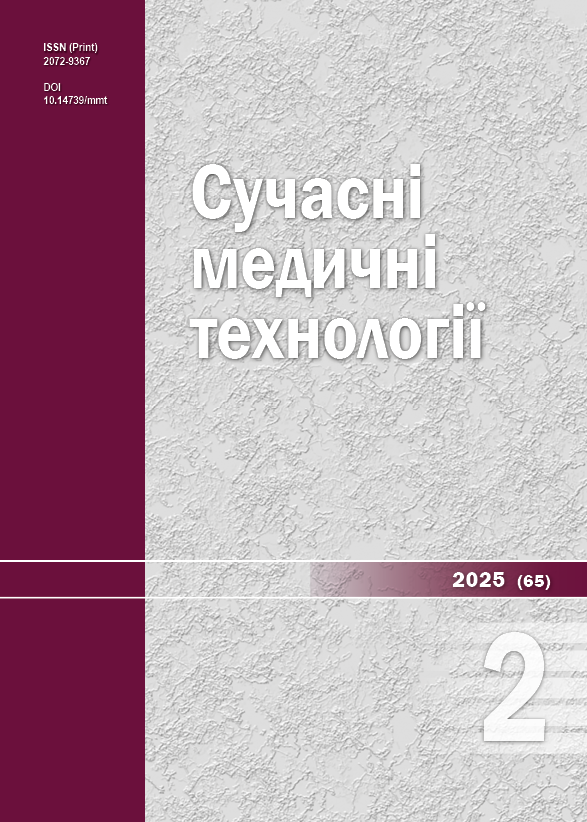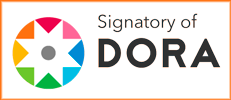Analysis of the effectiveness of extracorporeal shock wave therapy in the treatment of orthopedic foot diseases at the current stage (literature review)
DOI:
https://doi.org/10.14739/mmt.2025.2.322356Keywords:
extracorporeal shock wave therapy, orthopedic foot diseases, plantar fasciitis, Achilles tendon, tendinopathyAbstract
Extracorporeal shock wave therapy (ESWT) continues to be a procedure with broad indications for use in orthopedic diseases, including the foot. One of the most common orthopedic diseases of the foot is plantar fasciitis and Achilles tendon tendinopathy. In recent years, the number of articles on tendinopathies has increased, and one of the most popular areas of research is diseases of the musculoskeletal system.
The aim of the study was to analyse the data from the current literature for review, to identify orthopedic diseases of the foot for the treatment of which the method of extracorporeal shock wave therapy was used, and to determine the effectiveness of the ESWT method for each of the diseases.
Material and methods. Literature sources from the scientometric electronic databases PubMed, Medline, Scopus, and Web of Science were selected and analysed. The search queries “ESWT”, “extracorporeal shock wave therapy” were used for the search. There were no language restrictions on the search for studies. The following information was extracted from each selected publication: study title, list of authors, year of publication, basic information about the study (type of study, number of patients), treatment parameters, duration of treatment, evaluation period, and study results. Articles from the last 5 years, i. e. from 2020 to 2024 inclusive, were separated from the selected articles.
Results. Based on the search results, 1771 scientific articles were selected. An analysis of the selected articles was conducted, orthopedic diseases of the foot were identified in the treatment of which extracorporeal shock wave therapy was used, and the effectiveness of the procedure itself for each disease was assessed. As a result, 36 articles were selected, which were used for the final analysis of the literature. The selected articles were distributed by the type of foot diseases in which the ESWT method was used. According to the search data, ESWT was used in the treatment of plantar fasciitis, Achilles tendon tendinopathy, and plantar fibromatosis.
Conclusions. According to the literature, extracorporeal shock wave therapy has been used in the treatment of plantar fasciitis, Achilles tendon tendinopathy, plantar fibromatosis, and partial damage to Achilles tendon. Extracorporeal shock wave therapy remains a relevant and effective method of treatment for the most common foot diseases.
References
Zhao H, Wu L, Yan G, Chen Y, Zhou M, Wu Y, et al. Inflammation and tumor progression: signaling pathways and targeted intervention. Signal Transduct Target Ther. 2021;6(1):263. doi: https://doi.org/https://doi.org/10.1038/s41392-021-00658-5
Yuk HD, Ku JH. Role of Systemic Inflammatory Response Markers in Urothelial Carcinoma. Front Oncol. 2020;10:1473. doi: https://doi.org/https://doi.org/10.3389/fonc.2020.01473
Kostenko V, Akimov O, Gutnik O, Kostenko H, Kostenko V, Romantseva T, et al. Modulation of redox-sensitive transcription factors with polyphenols as pathogenetically grounded approach in therapy of systemic inflammatory response. Heliyon. 2023;9(5):e15551. doi: https://doi.org/https://doi.org/10.1016/j.heliyon.2023.e15551
Dolan RD, McMillan DC. The prevalence of cancer associated systemic inflammation: Implications of prognostic studies using the Glasgow Prognostic Score. Crit Rev Oncol Hematol. 2020;150:102962. doi: https://doi.org/https://doi.org/10.1016/j.critrevonc.2020.102962
Mleko M, Pitynski K, Pluta E, Czerw A, Sygit K, Karakiewicz B, et al. Role of Systemic Inflammatory Reaction in Female Genital Organ Malignancies - State of the Art. Cancer Manag Res. 2021;13:5491-508. doi: https://doi.org/https://doi.org/10.2147/CMAR.S312828
Yelins’ka AM, Akimov OY, Kostenko VO. Role of AP-1 transcriptional factor in development of oxidative and nitrosative stress in periodontal tissues during systemic inflammatory response. Ukr Biochim J. 2019;91(1):80-5. doi: https://doi.org/https://doi.org/10.15407/ubj91.01.080
Sogbein O, Paul P, Umar M, Chaari A, Batuman V, Upadhyay R. Bortezomib in cancer therapy: Mechanisms, side effects, and future proteasome inhibitors. Life Sci. 2024;358:123125. doi: https://doi.org/https://doi.org/10.1016/j.lfs.2024.123125
Mao Y. Structure, dynamics and function of the 26S proteasome. In: Harris JR, Marles-Wright J, editors. Macromolecular Protein Complexes III: Structure and Function. Subcell Biochem. Cham: Springer; 2021. Vol. 96. doi: https://doi.org/https://doi.org/10.1007/978-3-030-58971-4_1
Zhu X, Yu J, Hua M, Xu N, Wang L, Chen L, et al. Function of NLRP3 inflammasome activation in multiple myeloma. Hematology. 2024;29(1):2399367. doi: https://doi.org/https://doi.org/10.1080/16078454.2024.2399367
Lassoued S, Moyano C, Beldjerd M, Pauly P, Lassoued D, Billey T. Bortezomib improved the joint manifestations of rheumatoid arthritis in three patients. Joint Bone Spine. 2019;86(3):381-2. doi: https://doi.org/https://doi.org/10.1016/j.jbspin.2019.01.019
Liu C, Zhou J, Wang B, Zheng Y, Liu S, Yang W, et al. Bortezomib alleviates myocardial ischemia reperfusion injury via enhancing of Nrf2/HO-1 signaling pathway. Biochem Biophys Res Commun. 2021;556:207-14. doi: https://doi.org/https://doi.org/10.1016/j.bbrc.2021.03.154
Chen X, Chen Y, Ou Y, Min W, Liang S, Hua L, et al. Bortezomib inhibits NLRP3 inflammasome activation and NF-κB pathway to reduce psoriatic inflammation. Biochem Pharmacol. 2022;206:115326. doi: https://doi.org/https://doi.org/10.1016/j.bcp.2022.115326
Klimas R, Sgodzai M, Motte J, Mohamad N, Renk P, Blusch A, et al. Dose-dependent immunomodulatory effects of bortezomib in experimental autoimmune neuritis. Brain Commun. 2021;3(4):fcab238. doi: https://doi.org/https://doi.org/10.1093/braincomms/fcab238
Sato H, Matsuda K, Amagai Y, Tanaka A, Matsuda H. Suppressive effect of bortezomib on LPS-induced inflammatory responses in horses. J Equine Vet Sci. 2018;61:114-20. doi: https://doi.org/https://doi.org/10.1016/j.jevs.2017.05.003
Yang CH, Liu YC. Inhibitory effects of proteasome inhibitor bortezomib on endotoxin-induced uveitis in Lewis rats. Invest Ophthalmol Vis Sci. 2010;51(13):827.
Tilahun AY, Theuer JE, Patel R, David CS, Rajagopalan G. Detrimental effect of the proteasome inhibitor, bortezomib in bacterial superantigen- and lipopolysaccharide-induced systemic inflammation. Mol Ther. 2010;18(6):1143-54. doi: https://doi.org/https://doi.org/10.1038/mt.2010.53
Chen FT, Yang CM, Yang CH. The protective effects of the proteasome inhibitor bortezomib (velcade) on ischemia-reperfusion injury in the rat retina. PLoS One. 2013;8(5):e64262. doi: https://doi.org/https://doi.org/10.1371/journal.pone.0064262
Kozaeva R, Klymenko MO, Katrushov OV, Kostenko VO. Bioflavonoids as agents for correcting nitro-oxidative stress and salivary gland functions in rats exposed to alcohol during modeled lipopolysaccharide-induced systemic inflammatory response. Wiad Lek. 2022;75(3):685-90. doi: https://doi.org/https://doi.org/10.36740/WLek202203121
Akimov OY, Kostenko VO. Functioning of nitric oxide cycle in gastric mucosa of rats under excessive combined intake of sodium nitrate and fluoride. Ukr Biochem J. 2016;88(6):70-5. doi: https://doi.org/https://doi.org/10.15407/ubj88.06.070
Frenkel Y, Cherno V, Kostenko H, Chopra H, Gautam RK, Kostenko V. Dietary Supplementation with Resveratrol Attenuates Serum Melatonin Level, Pro-Inflammatory Response and Metabolic Disorder in Rats Fed High-Fructose High-Lipid Diet under Round-the-Clock Lighting. Pathophysiology. 2023;30(1):37-47. doi: https://doi.org/https://doi.org/10.3390/pathophysiology30010005
Kozaeva RS, Klymenko MO, Kostenko VО. [Lipopolysaccharide-induced systemic inflammatory response enhances the development of oxidative-nitrosative stress in salivary glands of rats under alcohol damage]. Fiziologichnyi zhurnal. 2021;67(6):60-7. Ukrainian. doi: https://doi.org/https://doi.org/10.15407/fz67.06.060
Guo Q, Jin Y, Chen X, Ye X, Shen X, Lin M, et al. NF-κB in biology and targeted therapy: new insights and translational implications. Signal Transduct Target Ther. 2024;9(1):53. doi: https://doi.org/https://doi.org/10.1038/s41392-024-01757-9
Frenkel YD, Cherno VS, Kostenko VO. Nrf2 induction alleviates metabolic disorder and systemic inflammatory response in rats under a round-the-clock lighting and high-carbohydrate-lipid diet. Rom J Diabetes Nutr Metab Dis. 2022;29(2):194-201. doi: https://doi.org/https://doi.org/10.46389/rjd-2022-1092
Gao W, Guo L, Yang Y, Wang Y, Xia S, Gong H, et al. Dissecting the Crosstalk Between Nrf2 and NF-κB Response Pathways in Drug-Induced Toxicity. Front Cell Dev Biol. 2022;9:809952. doi: https://doi.org/https://doi.org/10.3389/fcell.2021.809952
Gao T, Chen S, Han Y, Zhang D, Tan Y, He Y, et al. Ameliorating Inflammation in Insulin-resistant Rat Adipose Tissue with Abdominal Massage Regulates SIRT1/NF-κB Signaling. Cell Biochem Biophys. 2022;80(3):579-89. doi: https://doi.org/https://doi.org/10.1007/s12013-022-01085-1
Yousefi Zardak M, Keshavarz F, Mahyaei A, Gholami M, Moosavi FS, Abbasloo E, et al. Quercetin as a therapeutic agent activates the Nrf2/Keap1 pathway to alleviate lung ischemia-reperfusion injury. Sci Rep. 2024;14(1):23074. doi: https://doi.org/https://doi.org/10.1038/s41598-024-73075-7
Downloads
Additional Files
Published
How to Cite
Issue
Section
License
Copyright (c) 2025 O. M. Ovchynnikov

This work is licensed under a Creative Commons Attribution-NonCommercial 4.0 International License.
The work is provided under the terms of the Public Offer and of Creative Commons Attribution-NonCommercial 4.0 International (CC BY-NC 4.0). This license allows an unlimited number of persons to reproduce and share the Licensed Material in all media and formats. Any use of the Licensed Material shall contain an identification of its Creator(s) and must be for non-commercial purposes only.














